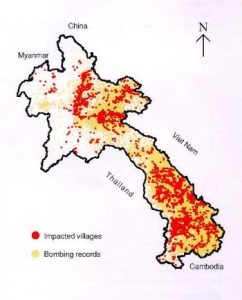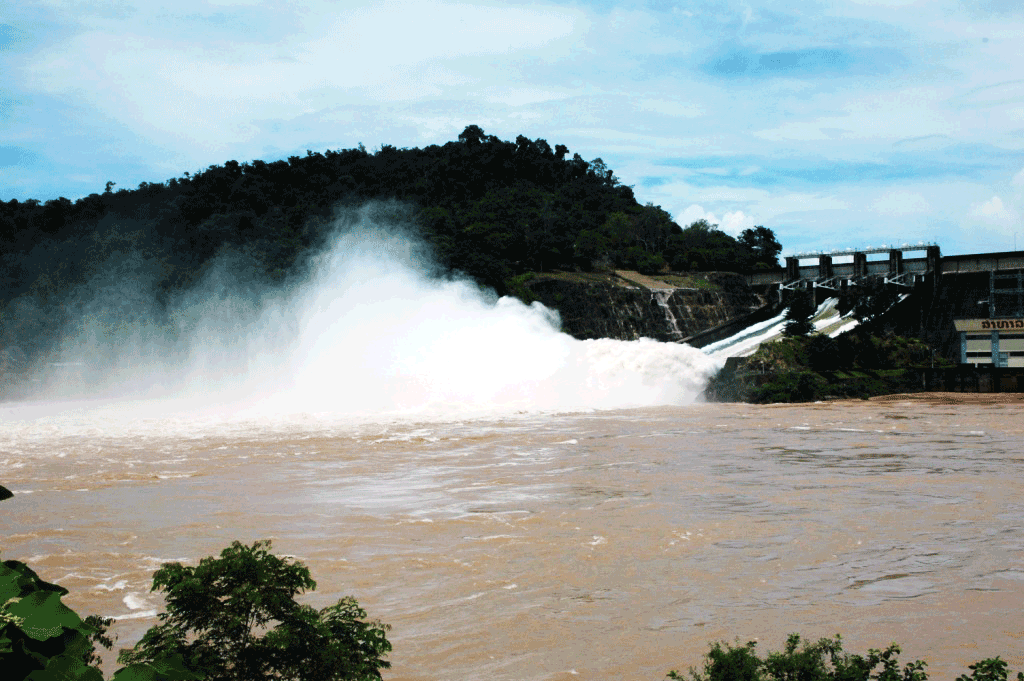This section focuses mainly on the production, distribution and use of electrical energy in Laos. In Laos, electricity is a key source of energy for domestic economic activities and its export provides revenue from neighboring countries.1
After an economic shift to an ‘open door’ policy in 1986, economic development has become rapid, with a change from mainly agriculture-oriented activities to development in other sectors including services and industry. As a result, energy demand has dramatically increased. The rapidly rising demand can best be seen in the growth 1990 to 2013 – while total energy demand was approximately 1,112 kTOE (kilotons of oil equivalent) in 1990, it had increased by 140 percent to 2,666 kTOE by 2013.2
The rising energy consumption in Lao PDR is attributable to its growing population as well as booming economic development.3 From 2014 to 2018 alone, electricity consumption rose from 2.4 billion kWh to 4.24 billion kWh.4 Efficient electrical supply and access are fundamental to meeting the rising energy demand Lao PDR faces and the development goals it has set.
Currently, 80.3 percent of the rural population and 97.4 percent of the urban population have access to electricity.5 However, the government has a goal to provide access to electricity for at least 98 percent of the population by the end of 2030.6 To achieve this goal, several laws and policies on the development of the energy sector have been adopted. Cooperation with private parties, other governmental agencies and development partners will also play a critical role.
The key challenges facing Laos’ energy sector and its expansion are:7
- inaccessible terrain
- widespread presence of unexploded ordnance, especially in rural areas
- low economic growth within inaccessible provinces
- rural populations that are difficult to reach.

UXO-contaminated regions of the country. Source: https://laos.pp.opendevelopmentmekong.net/dataset/?id=nama-for-the-renewable-energy-sector-in-laos
Lao PDR works to use its central location to its economic advantage, specifically as a land-locked country.8 Laos trades a great deal of electricity with Thailand and its other neighboring countries Vietnam and Cambodia. By 2030, it aims to increase overall power exports to 15,000 MW – 10,000 MW going to Thailand and 5,000 MW going to Vietnam, Cambodia and Myanmar.
Energy consumption and demand
Biomass consumption is the most abundant energy resource in the country and often does not need to be purchased. In 2013, biomass consumption was 1.27 MToe, which made up 51.3 percent of TPEC. The second highest consumed energy source was oil products. There are no oil refineries in Lao PDR, so imports come from Thailand and Vietnam.
Energy production
In 2013, Lao PDR’s total primary energy supply (TPEC) was 2.47 MToe. The primary energy mix was oil, hydropower, coal, and biomass. Most of the electricity (56 percent) is produced by hydro dams.9
Non-renewable energy production
Around 20 percent of primary energy demand is met by nonrenewable energy sources which include oil (17 percent) and coal (3 percent).10 Currently, Lao coal reserves are estimated at 600–700 million tons, mainly consisting of lignite with small amounts of anthracite.11 Coal consumption is limited to a cement factory, which uses about 35,000 tons per year, and a few other smaller users. As for oil and natural gas, there have been no proven resources of them found in the country to date.
Non-renewable energy fuels (oil, natural gas and coal) are the most commonly traded energy commodities, but reserves worldwide are being depleted.12 Because of this trend, and the negative environmental effects that non-renewable energy sources carry, Lao PDR is working to replace them with renewable and alternative sources.13
Renewable energy production
Approximately 80 percent of primary energy demand is met by renewable energy sources such as biomass (68 percent) and hydropower (12 percent).14 Biomass is used at the household level for cooking, and in small-scale rural industrial production like tobacco processing.15 The biomass energy sources are derived from the agriculture and forestry sectors that produce waste in the form of sawdust, corn cobs, and rice straw and husks. These add up to the equivalent of 500 million tons of oil.16 To expand biofuel development, Lao PDR is creating a national program with a goal of introducing 10 percent biofuel in the transport sector by 2025.17
Solar power systems also contribute to the production of renewable energy. Lao PDR has an average of 200–300 sunlight days per year, with a potential capacity of solar energy of 4.5–5.0 kWH/m² per day.18 Solar power, while not the main energy source, has incredible potential to play a critical role in off-grid electric power for remote rural areas. To date, around 13,000 households in remote areas have been equipped with solar home systems.
Scientific assessments for wind power potential have not yet been conducted in Laos. However, basic feasibility studies carried out in Nong and Xonbuly districts of Savannakhet Province revealed 64 MW of wind power potential.19
Hydropower dams
Hydropower is a key source of electrical energy in Lao PDR. The Mekong river sub-basins have approximately 20,000 MW of viable hydropower potential; by 2013, 2,971 MW of this had been developed.
Most hydropower dams are on tributaries on the Mekong River and supply over 3,240 MW of hydropower. The earliest major dam, the Nam Ngum 1 Hydropower plant, was built on the Ngum River in 1971 in Vientiane Province.20 Until the end of the 20th century, the dam supplied most of the electricity used in Laos, as well as providing energy for export to Thailand. The largest power plant in terms of generating capacity is the Nam Theun 2 project, expected to generate $2 billion USD in revenues over a twenty-year period.21 Aside from these two major dams, the Lao government has to date signed MOUs or is conducting research on more than 70 hydropower projects.22

Nam Ngum dam. Photo by massa, taken on August 30, 2005. Licensed under: CC BY-NC 2.0.
Within the broader category of hydropower is small hydropower – installations with less than 15 MW capacity. Small hydropower has an estimated potential of approximately 2,000 MW, making it a useful resource.
Government goals and plans
The government plans to increase the electrification rate to 90 percent by 2020, from 87 percent in 2013. Some other goals include:23
- increase the affordability and accessibility of modern forms of energy
- increase the share of renewable energy in the total energy supply by 30 percent in 2030
- increase access to electricity by grid extensions and off-grid rural electrification
- maintain an affordable tariff
- promote energy efficiency and conservation.
Hydropower Projects in Laos, 2014. Map created by ODM, view more on Map Explorer.
Related to the energy
References
- 1. Kouphokham, K. 2016. “‘Lao PDR Country Report’ in Kimura, S. and P. Han (eds.) in Energy Outlook and Energy Saving Potential in East Asia 2016.” ERIA Research Project Report 2015-5, Jakarta: ERIA, pp.193-213. Accessed 3 June 2018.
- 2. UNDP and Ministry of Energy and Mines. 2016. “NAMA for the Renewable Energy Sector of Lao PDR.” Accessed 3 June 2018.
- 3. Ibid. Accessed 4 June 2018.
- 4. Index Mundi. 2015. “Energy: Electricity – Consumption in Laos.” Accessed 4 June 2018.
- 5. Trading Economics. 2016. “Laos-Access to electricity.” Accessed 3 June 2018.
- 6. Xinhua. 2016. “Energy sector to become major GDP contributor in Laos.” Accessed 5 June 2018.
- 7. UNDP and Ministry of Energy and Mines. 2016. “NAMA for the Renewable Energy Sector of Lao PDR.” Accessed 5 June 2018.
- 8. Kouphokham, K. 2016. “‘Lao PDR Country Report’ in Kimura, S. and P. Han (eds.) in Energy Outlook and Energy Saving Potential in East Asia 2016.” ERIA Research Project Report 2015-5, Jakarta: ERIA, pp.193-213. Accessed 4 June 2018.
- 9. Energypedia. 2016. “Laos Energy Situation.” Accessed 4 June 2018.
- 10. Ibid. Accessed 3 June 2018.
- 11. UNESCAP. 2014. “Lao PDR National Sustainable Energy Strategy on Enabling Environment and Technology Innovation Ecosystem for Affordable Sustainable Energy Options.” Accessed 5 June 2018.
- 12. Lao Institute for Renewable Energy. 2011. “Renewable Energy Development Strategy in Lao PDR.”. Accessed 5 June 2018.
- 13. Ibid. Accessed 4 June 2018.
- 14. Energypedia. 2016. “Laos Energy Situation.” Accessed 4 June 2018.
- 15. Technology Research Institute, Science Technology and Environment Agency. “Renewable Energy Technology in Asia Project Implementation in Lao PDR”. Accessed 4 June 2018.
- 16. UNESCAP. 2014. “Lao PDR National Sustainable Energy Strategy on Enabling Environment and Technology Innovation Ecosystem for Affordable Sustainable Energy Options.” Accessed 5 June 2018.
- 17. Ibid. Accessed 3 June 2018.
- 18. Ibid. Accessed 4 June 2018.
- 19. Ibid. Accessed 5 June 2018.
- 20. Hydropower Sustainability Assessment Protocol 2005. “Multiple use benefits: Nam Ngum 1 Hydropower Plant, Lao PDR”. Accessed 5 June 2018.
- 21. The World Bank. 2017. “Nam Theun 2 Project Overview.” Accessed 4 June 2018.
- 22. Ministry of Energy and Mines. 2014. “Hydropower in Lao PDR.” Accessed 4 June 2018.
- 23. Kouphokham, K. 2016. “‘Lao PDR Country Report’ in Kimura, S. and P. Han (eds.) in Energy Outlook and Energy Saving Potential in East Asia 2016.” ERIA Research Project Report 2015-5, Jakarta: ERIA, pp.193-213. Accessed 3 June 2018.

